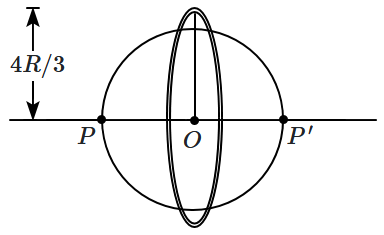| Statement I: | The gravitational force acting on a particle depends on the electric charge of the particle. |
| Statement II: | The gravitational force on an extended body can be calculated by assuming the body to be a particle 'concentrated' at its centre of mass and applying Newton's law of gravitation. |
| 1. | Statement I is incorrect and Statement II is correct. |
| 2. | Both Statement I and Statement II are correct. |
| 3. | Both Statement I and Statement II are incorrect. |
| 4. | Statement I is correct and Statement II is incorrect. |

To unlock all the explanations of this course, you need to be enrolled.

To unlock all the explanations of this course, you need to be enrolled.

| 1. | \(2\) km/s | 2. | \(2\sqrt2\) km/s |
| 3. | \(2(\sqrt2-1)\) km/s | 4. | \(2(\sqrt2+1)\) km/s |

To unlock all the explanations of this course, you need to be enrolled.

To unlock all the explanations of this course, you need to be enrolled.
| 1. | \(mgh\) | 2. | \(\Large\frac{mgh}{27}\) |
| 3. | \(\Large\frac{mgh}{\sqrt{27}}\) | 4. | \(\Large\frac{14mgh}{27}\) |

To unlock all the explanations of this course, you need to be enrolled.

To unlock all the explanations of this course, you need to be enrolled.
| 1. | \(\Large\frac{2GMm}{r^2(M+m)}\) | 2. | \(\Large\frac{GMm}{r^2(M+m)}\) |
| 3. | \(\Large\frac{G(M\text - m)}{r^2}\) | 4. | \(\Large\frac{G(M\text + m)}{r^2}\) |

To unlock all the explanations of this course, you need to be enrolled.

To unlock all the explanations of this course, you need to be enrolled.

| Column-I | Column-II | ||
| \(\mathrm{(A)}\) | Gravitational potential energy (PE) of interaction between the sphere and the ring. | \(\mathrm{(I)}\) | \(1.25\) |
| \(\mathrm{(B)}\) | Gravitational potential at the common centre \((O)\) | \(\mathrm{(II)}\) | \(1.36\) |
| \(\mathrm{(C)}\) | Gravitational potential at \(P,\) a pole of the sphere. | \(\mathrm{(III)}\) | \(2\) |
| \(\mathrm{(D)}\) | Gravitational field at \(P,\) a pole of the sphere. | \(\mathrm{(IV)}\) | \(2.75\) |
| 1. | \(\mathrm{A\text-I,B\text-IV,C\text-III,D\text-II}\) |
| 2. | \(\mathrm{A\text-II,B\text-III,C\text-I,D\text-IV}\) |
| 3. | \(\mathrm{A\text-III,B\text-II,C\text-IV,D\text-I}\) |
| 4. | \(\mathrm{A\text-I,B\text-IV,C\text-II,D\text-III}\) |

To unlock all the explanations of this course, you need to be enrolled.

To unlock all the explanations of this course, you need to be enrolled.
| 1. | \(\dfrac{GMm}{r^2}+\dfrac{2Gm^2}{r^2}\) |
| 2. | \(\dfrac{GMm}{r^2}+\dfrac{\sqrt3Gm^2}{r^2}\) |
| 3. | \(\dfrac{GMm}{r^2}+\dfrac{Gm^2}{\sqrt3r^2}\) |
| 4. | \(\dfrac{GMm}{r^2}+\dfrac{2Gm^2}{\sqrt3r^2}\) |

To unlock all the explanations of this course, you need to be enrolled.

To unlock all the explanations of this course, you need to be enrolled.
If a particle is projected vertically upward with a speed \(u,\) and rises to a maximum altitude \(h\) above the earth's surface then:
(\(g=\) acceleration due to gravity at the surface)
| 1. | \(h>\dfrac{u^2}{2g}\) |
| 2. | \(h=\dfrac{u^2}{2g}\) |
| 3. | \(h<\dfrac{u^2}{2g}\) |
| 4. | Any of the above may be true, depending on the earth's radius |

To unlock all the explanations of this course, you need to be enrolled.

To unlock all the explanations of this course, you need to be enrolled.
| 1. | \(mr\) | 2. | \(\dfrac{m}{r}\) |
| 3. | \(m\sqrt r\) | 4. | \(\dfrac{m}{\sqrt r}\) |

To unlock all the explanations of this course, you need to be enrolled.

To unlock all the explanations of this course, you need to be enrolled.
| 1. | \(U > mgh\) |
| 2. | \(U < mgh\) |
| 3. | \(U = mgh\) |
| 4. | any of the above may be true depending on the value of \(h,\) considered relative to the radius of the earth. |

To unlock all the explanations of this course, you need to be enrolled.

To unlock all the explanations of this course, you need to be enrolled.

| 1. | \(\dfrac{m_{1}}{x_{1}}=\dfrac{m_{2}}{x_{2}} \) | 2. | \(\dfrac{m_{1}}{x_{1}^{2}}=\dfrac{m_{2}}{x_{2}^{2}} \) |
| 3. | \(\dfrac{m_{1}}{x_{1}^{3}}=\dfrac{m_{2}}{x_{2}^{3}} \) | 4. | \(m_{1} x_{1}=m_{2} x_{2} \) |

To unlock all the explanations of this course, you need to be enrolled.

To unlock all the explanations of this course, you need to be enrolled.






